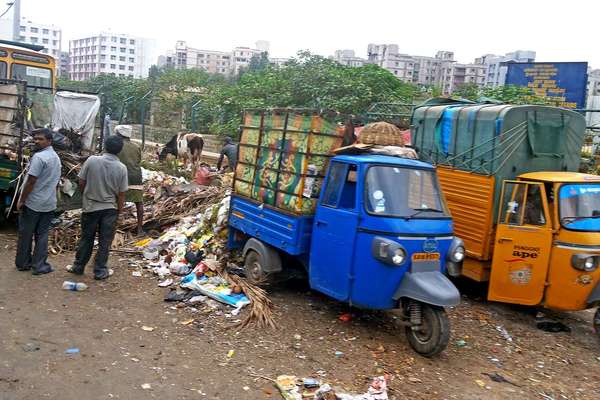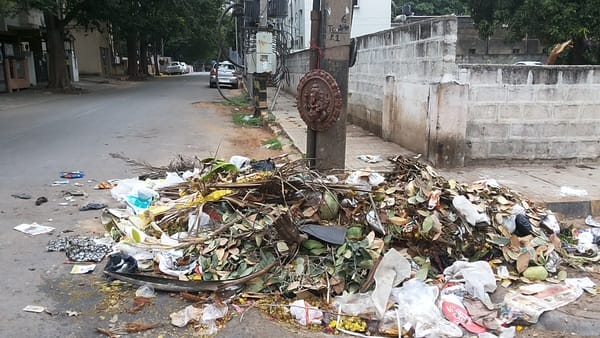While the government and the BBMP seem to be boasting of making Bangalore garbage-free under Kasamukta Bengaluru, the ground reality is far different. Though there seems to be slight there is slight improvement in some areas, most areas in Bangalore remain neglected.
Garbage – dry, wet, organic, inorganic, medical, degradable, non-degradable – everything can be seen littered across the city. The garbage mounds in the landfills never stop increasing. On an average, a ward generates 2-3 tons of dry waste, per day. And if locals are to be believed, around 80% of this waste is thrown in the landfills.

Waste management remains a mess across the city. File Pic
What is the Kasamukta project?
Kasamuktha is a project aimed at making Bangalore garbage-free. Under this project, the idea is to segregate waste at source and handle it separately (wet and dry separately). Wet waste is used for composting, while dry waste is sent to dry waste collection centres and given for recycling. Only the remaining non-recyclable waste is sent to landfills. The idea was to manage the waste locally and reduce the transportation of waste and dumping in landfills.
When the programme was launched in July 2013, 22 wards were chosen. Ejipura, JP Nagar, Koramangala, Pattabhiramanagar, V Nagenahalli, Shantalanagar, Konanakunte, RR Nagar, Sarakki, Rajmahal Guttahalli, Gangenahalli, Dattatreya Devasthana, HSR Layout, Chokkasandra, Nagapura, Gandhinagar, Kadumalleshwara, J C Nagar, Marappanapalya, Kengeri, Attur and Yelahanka were the chosen wards for the pilot.
In six months, the city was to become free of garbage, as per the instructions of the Chief Minister, Siddaramaiah. One more month is left for his deadline.
Citizen Matters did a reality check of Bangalore’s three wards, just to get a feel of the awareness and practice of waste management, post-Kasamukta campaign launch.
Hegganahalli: Unwilling citizens, unpaid contractors
This ward is not included in the Kasamukta pilot project list. Spread across 1.96 sq kms, the ward has a combination of residential and commercial establishments.
Garbage management is very limited in this ward. Mixed garbage piled up on road sides makes a good breeding ground for mosquitoes. The garbage is burnt when the pile and stink becomes unbearable, especially after festive seasons.
Restaurants and other commercial units in the vicinity throw their garbage on the roadside when the pourakarmikas are on leave. The waste water is also let into the road sides and mosquitoes can be seen breeding on them. Little attention is paid to cleanliness here.
Most of the dwellers here do not segregate waste. But those who do complain that the pourakarmikas are mixing the garbage in one bin and disposing it inappropriately. Pourakarmikas are also seen throwing the waste on road sides or in open areas. The garbage collection van is absent on most days of the month, thus street dogs and cattle can be seen feeding on them. Such black spots are a common site in every place. Residents also complain that the piled up garbage is leading to a lot of health problems. They also live in the fear of being bitten by dogs.
But the BBMP health inspector Santosh, thinks otherwise. He says that the waste is being segregated and is being well-managed. Spraying is ongoing to curtail all health problems, according to him.
M B Govinde Gowda, the corporator of the ward, accepts his failure in making the ward garbage-free. He says: “There is no end to Kasa in Bangalore as garbage will never end. The problem in this ward is, the contractor and labourers complain that they are not paid on time so they do not take any interest in clearing the garbage. Thus garbage is piled up and set ablaze. The matter has been brought to the notice of the Mayor and Commissioner, who have assured to hold meetings with the contractor and solve the issue.”
Jakkasandra: No basic awareness
Located next to Koramangala, one of the posh areas of Bangalore, Jakkasandra doesn’t really have a good system of garbage management. This ward is not a part of the Kasamukta Bangalore project ward list though. The area is spread across 1.52 sqkm, and comprises areas like KSRP Quarters, Teachers colony, Jakkasandra, Venkatapura and HSR Layout- Sector 5 (P).
The garbage can be seen dumped on interior roads. Most of the residents do not segregate waste. The waste is being collected in trucks and sent to landfill sites, barring some attempt to pick valuable plastic by rag pickers.
The civic workers point that despite requesting, many residents do not segregate garbage at source. All the garbage is seen dumped in one single bin. On the other hand, residents complain that the garbage is collected in one vehicle and mixed together.
The garbage truck workers segregate whatever possible, by their bare hands. They have no gloves or masks to protect themselves from the foul smell and hazardous waste.
The important market junctions need a lot of attention. Black spots are common in this ward. People are forced to walk past them with their nose and mouth covered. Cattle and street dogs can be seen feeding on them. These sites are also breeding grounds for mosquitoes.
Roadside eateries, which are a big hit among the youth, are seen dumping waste near their units. At night, a lot of garbage can be seen dumped along footpaths. The garbage is cleared mostly during early morning hours, but when the pourakarmikas are on leave, the ugly truth comes out.
But, health officials of the BBMP who did not want to be named say that there is nothing to worry and things are under control. They claim to have not received any complaints from people about any health problems or garbage menace.
Saraswathamma, the corporator of the ward, says that there is no government land available in the ward to store and segregate garbage. She says: “There is no place to segregate dry waste. People are also not segregating waste at source. Kasamukta project is not effective here, as nothing is happening. No plans have been chalked out for the future. All the garbage is collected by the pourakarmikas, put in lorries and send to the landfill sites.”

A black spot in Malleshwaram Pic: Shree D N
Kadu Malleshwara: Donkeys feast here on garbage
The area spread across 1.36 sqkm comprises of residential and commercial establishments. This is one of the oldest areas of Bangalore. It is also termed as a planned ward, and has been listed in the Kasamukta pilot project. But the truth is, many residents do not segregate garbage. Garbage is seen dumped by the side of many prominent roads. Stray cattle like donkeys, cows and stray dogs feed on the garbage. As soon as the garbage truck takes away the waste from a dump, another batch of waste starts getting piled.
Residents point that sometimes pourakarmikas do not clear the garbage. While many segregate garbage at source and hand it over to the workers, commercial establishments are not bothered.
Some apartment complexes are managing their own waste, but there are many who are not bothered. Residents point that many people here just want their compound or lane area to be clean and are not bothered of the next lane.
According to residents, Kasamukta project hasn’t achieved much here. Even if the waste is segregated and handed over to pourakarmikas, many of them mix it in one bin. The garbage collectors take the dry waste to the dry waste collection centre behind Chowdaiah Memorial Hall, while wet waste is supposed to be processed at the organic convertor near the DWCC, but the truth is the wet waste is sent to landfill.
There is no incineration centre to burn sanitary waste separately – sanitary waste is mixed up with other waste and ultimately goes to landfills. They don’t collect it separately.
G Manjunatha Raju, the corporator, says that work towards making Kasamukta ward is underway. “We have achieved 50-60% success in making people aware, segregating waste and managing it. Attention still needs to be paid to arterial roads. It is difficult to change the mindset of people. Help from volunteers of My Clean Malleswaram is also being taken to make the ward better. There is a long way to clear Blackspots,” he says.
Audit of works in December: Lakshminarayan
BBMP Commissioner N Lakshminarayan, told Citizen Matters that they are presently concentrating on dry waste management. “Waste is being collected from the pourakarmikas and being sent to the dry waste collection centres. This includes paper, plastic, metal, glass and so on. An audit of the works and waste management will be done in December, following which the project will be implemented in the remaining 105 wards.”
He adds: “Kasa Mukta project which was introduced in 22 wards on pilot basis has been 65% successful in the collection of dry waste. There are some people who still are not segregating waste at source. We have collected around Rs 10 lakh as fine, in the last one-and-half months alone. This money will be utilised for better garbage management.”
He adds that the concentration is presently on city’s core areas. The department will work in Bangalore South, East and West. Later, it will be extended to the newly added 110 wards.
Related Articles
Let’s roll our sleeves up, it’s our garbage!
A large scale composting model Bangalore’s apartments can emulate
Understanding how to segregate waste
How to segregate waste in offices?
How to segregate waste in apartments?
‘Kasa Muktha’ could mark new era in Bangalore’s waste management